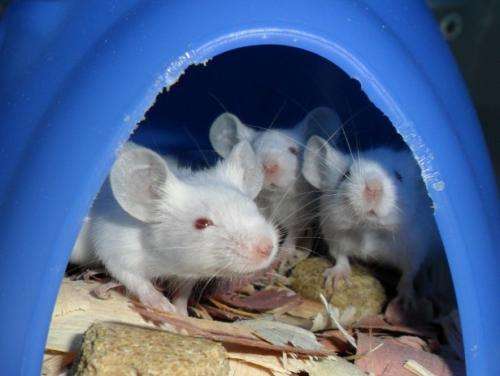Credit: Martha Sexton/public domain
Genetically engineering tumors in mice, a technique that has dominated cancer research for decades, may not replicate important features of cancers caused by exposure to environmental carcinogens, according to a new study led by UC San Francisco scientists. In addition to pointing the way to better understanding of environmental causes of cancer, the findings may help explain why many patients do not benefit from, or develop resistance to, targeted drug therapies.
In the new research, reported November 2, 2014 in the advance online edition of Nature, a team led by UCSF graduate student Peter M.K. Westcott found that chemically induced lung tumors in mice carry hundreds of point mutations—deleterious alterations of single "letters" in the genome—that are not present in tumors induced by genetic engineering. The researchers demonstrated that chemically induced tumors display a starkly different "mutational landscape" even when chemicals cause a tumor-initiating mutation that is identical to that created by direct genetic manipulation.
"Since the 1980s, when genetic engineering came along, the mouse model community has been working on genetically engineered cancer—you put a gene in or take a gene out, and you get a tumor," said Allan Balmain, PhD, the Barbara Bass Bakar Distinguished Professor in Cancer Genetics at UCSF and senior author of the study. "But it's only now that we're beginning to analyze what has happened between that first engineered change and the ultimate development of an aggressive tumor."
The new work made use of next-generation sequencing (NGS) technology, which allows researchers to analyze the genomic sequence of tumors or of normal tissue letter-by-letter. For the Nature study, the group used a form of NGS known as whole-exome sequencing, which comprehensively analyzes the portion of the genome that contains the code for producing proteins.
The findings dovetail well with those from NGS-based studies of human tumors, such as The Cancer Genome Atlas (TCGA) initiative spearheaded by the National Cancer Institute and National Human Genome Research Institute, which have revealed mutational "signatures," some of which can be definitively tied to environmental exposures. For example, distinctive patterns of point mutations are now known to differentiate lung cancer in smokers from that affecting non-smokers.
The results are also consistent with observations that tumors arising in human organs that are most directly exposed to environmental carcinogens—the skin, gastrointestinal system, and lungs—are more prone to point mutations than more "protected" organs such as the brain, breast, and prostate gland.
"We humans smoke cigarettes, drink alcohol, and spend too much time in the sun, all of which cause us to accumulate point mutations that are major determinants of the behavior of tumors, especially of how a tumor responds to therapy," said Balmain, co-leader of the Cancer Genetics Program at UCSF's Helen Diller Family Comprehensive Cancer Center. "All this heterogeneity is being missed with genetically engineered tumors, because they don't reflect these environmental effects."
But only a very small number of the 25 mutational signatures revealed by NGS in human tumors so far have been convincingly tied to environmental exposures, Balmain said, so there is much to learn. "Other very unusual, very specific signatures have been seen in human studies that remain obscure. They're like a 'smoking gun'—we know they're caused by something environmental, but we're not sure what."
To date most epidemiological research on environmental causes of cancer has relied on patients and families to recall and document dietary habits, alcohol and tobacco use, or occupational exposures, and the rise of NGS offers an opportunity to approach these questions more rigorously, said Balmain.
To that end, Balmain's research group is embarking on a collaboration with the National Institute of Environmental Health Sciences, which maintains a collection of thousands of mouse and rat tumors caused by exposure to suspected human carcinogens. Through NGS analyses of that collection, the research team hopes to find mutational signatures that can be correlated with those seen in human cancer.
"We hope that we're at the beginning of a reawakening interest in the environment as an inducer of cancer," Balmain said. "And because many targeted therapies are being tested in genetically engineered models, we're hoping that new models that incorporate environmental effects may give us a truer picture of their eventual effectiveness."
More information: "The mutational landscapes of genetic and chemical models of Kras-driven lung cancer." Published online 02 November 2014 Nature (2014) DOI: 10.1038/nature13898
Journal information: Nature
Provided by University of California, San Francisco





















